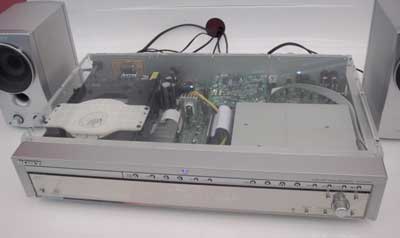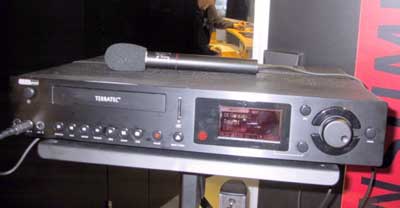CeBIT 2002 Part 1 - A/V Devices & More
by Tillmann Steinbrecher on March 18, 2002 12:00 PM EST- Posted in
- Trade Shows
Hard drive based audio recorders
In addition to the MP3 players and the new "NetMD" minidisc units,
Sony also presented a hard drive-based audio recorder. This unit comes
in a very stylish case and is equiped with a 40 GB hard drive.

This unit, however, uses ATRAC3 for audio compression. The default
bitrate for encoding is 132kbit/s; copying from the CD to the HD
is done at 2x speed. The unit is compatible with copy-protected
CDs (e.g. Cactus Data Shield).
It cannot even play MP3s, and what's worse: it cannot
read CD-R or CD-RW media at all. You can't even play the music you
recorded yourself on a burnt audio CD on it! The player has an USB
interface, but it can only be used for controlling it from the PC
- music transfer to and from the PC is not possible. The unit doesn't
even feature an SP/DIF out put - a feature that is standard now
even on low-end CD players.
The recorder has a two-line text-only display, which is behind a
mirror-like surface; it looks cool, but is a little hard to read
under certain lighting conditions.
It is obvious that this recorder is designed with the interest of
the music industry in mind (and that includes Sony itself), and
not to meet the wishes of the potential customers.
The price for this unit will be $880 at the time of writing of this
article. The big question is: Who is going to buy this? PC enthusiasts
are certainly going to avoid it because of the lack CD-R and MP3-support,
and the inability to exchange files using the PC. And audiophile
HiFi-enthusiasts probably won't buy it either, because of its low
bitrate encoding.
A much, much more interesting hard drive based audio recorder was
presented from a company that isn't quite as well-know as Sony:
Terratec.

Just like the Sony unit, it features a 40GB hard drive - but
this is where the similarities end. The Terratec unit uses the
Fraunhofer MP3 codec for compression; MP3 encoding at bitrates
from 64K to 320K CBR are supported. The recorder has an easy-to-use
and easy-to-read graphical interface; navigation is done using
the jog-dial on the right.
The recorder has some interesting features for coping with the
large amount of music titles stored on it. You can define and
combine rules based on ID3 tag information - e.g. you can tell
the unit something like "show all Jazz from 1970 to 1975".
Using the USB port, it is possible to control the unit from
the PC, and exchange files in both directions. CD title recognition
is done using the "Gracenote" database, which is installed locally
on the HD, and can be updated via PC or CD. The recorder has
all relevant in- and outputs, including SP/DIF in and out.
As for the technical details: The recorder uses an ARM processor,
and runs a proprietary operating system. No info on the DAC
chips used or the specs of the analog part of the unit were
supplied. But even in the case that the analog output isn't
great (which we don't know yet - with the small speakers and
the background noise on the Terratec stand it was impossible
to judge the sound quality), it is possible to use the unit
with an external DAC or use a DAT or Minidisc recorder for the
digital/analog conversion, since the Terratec recorder features
an SP/DIF output. This, together with the possibility of using
a high encoding bitrate, should make this recorder interesting
even for very audiophile Hifi users.
While all this sounds good, the unit isn't flawless. First of
all, it can only copy CDs at 1x speed. And second, it does not
support copy-protected CDs. The reason for this is not technical,
but legal: with laws made to defend the interests of the music
industry in Europe, bypassing even the most simple copy protection
is illegal.
The price of the Terratec recorder is identical to the Sony's,
$880.










1 Comments
View All Comments
Dragonrest - Tuesday, August 17, 2021 - link
Its so old https://m.dragonrest.net